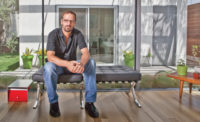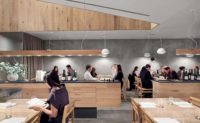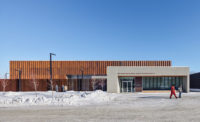With an intriguing form and striking street presence, the recently opened ARRIVE hotel in Austin, Texas, challenges its neighbors in a rapidly developing area of the city to step out of their comfort zone—much as the architects and their clients did for this $25 million project, which represents a jump in scale and budget for both parties.
Behind a dark gray ironspot-brick facade, banded by tilting horizontal ribbons of concrete, ARRIVE contains 83 guest rooms and two restaurants, in addition to a bar, coffee shop, and a small retail space. “It’s more like a mixed-use building that happens to have hotel rooms above,” says design architect Burton Baldridge, founder of the 2015 Record Vanguard firm Baldridge Architects in Austin. Since its founding in 2006, the office has taken on projects ranging from single-family residences to the adaptive reuse of buildings for a restaurant and for a university.
Prior to this project, Baldridge worked for more than a year on another hotel concept, elsewhere in Austin, with Los Angeles–based ARRIVE Hotels, an emerging developer and operator of boutique hotels and restaurants, and local hospitality company Alexa Management. Mired in zoning and entitlements problems, that project was eventually scrapped, so the team pivoted to a new design in a less problematic location along a transit-oriented corridor in East Austin, occupied only by a low-slung vacant building from 1992, which they removed, and a small masonry structure.
The clients asked Baldridge to design a building that “questioned traditional hotel tropes,” he says, with amenities that would appeal to both guests and locals. The scheme answers this by forgoing a large lobby in favor of highlighting food and beverage establishments, which intentionally read as independent from the rest of the building. Furnishings, lighting, and decor endow public spaces with the feeling of a living room rather than a waiting room. The check-in experience, too, is different, taking place at the bar of the restaurant Vixen’s Wedding (the interiors there were led by Austin design studio McCray & Co.). “They don’t want you to walk up to a lobby where a dude at a computer is standing behind a desk,” says Baldridge. Instead, “you come in, get a drink, and leave your bags.”
The building’s exterior also shrugs off norms. Its material palette nods to the neighborhood, where concrete and brick warehouses are common. “We found that language peppered throughout East Austin and gravitated to it,” says Baldridge. But ARRIVE stands out because of its darkly hued masonry, which carries through to the public spaces inside, and its surprising, dynamic form. “We didn’t want a grid of windows that you can read as ‘hotel room, hotel room, structural bay, hotel room,’ from the outside,” says Baldridge. Tipping the concrete bands slightly off level makes the glazing in each room different, with windows stretching from ceiling to floor in some but only to waist height in others. This off-kilter framework also enables large terraces for corner rooms on every other floor. It makes for an enigmatic facade—but also presented quite the challenge during fit-out. Coupled with undulations in the depth of the building (a response to a city ordinance requiring setbacks from the street), the diverse glazing configurations mean that there are 28 different types of room, and some further permutations within those types.
ARRIVE Hotels, the company, typically seeks out aging buildings in interesting neighborhoods that they can adapt. In hospitality, “the architecture itself needs to feel like the place, and that’s more challenging when you do new construction,” says Chris Pardo, an architectural and interior designer, who cofounded the company in 2012 with four partners and, in addition to his role as developer, led the design of many of the hotel’s interior spaces. But the Austin real-estate market did not offer many options of appropriate old building stock. Still, the team was able to repurpose a small redbrick building on the site—complete with its graffiti—into Lefty’s Brick Bar, an open-air Cajun-Vietnamese fusion restaurant.
For Baldridge, designing something of this scale—the firm’s largest project yet—was a thrilling professional development. “We were still kind of pinching ourselves well into the process, excited that somebody was letting us do this,” the architect says. By riffing on the vernacular, ARRIVE manages to both embrace and challenge its context, inviting guests and neighbors alike to do the same.









